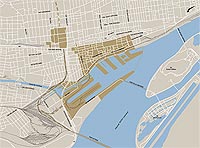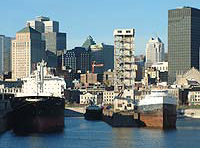|
|
 |
 |
 |
| Click on the map to enlarge it. |
|
 |
 |
|
 |
 |
|
 |
| As both players and onlookers
in Montreal's historic role as a North American hub, the
historic city centre, the old port and the railway station
district form a remarkable group of heritage properties,
a result of Montreal's location at the exact breakpoint
for shipping on the St. Lawrence River, making it a major
gateway to North America. Better yet, because Montreal
grew into a metropolis but never a megalopolis, this group
of heritage assets is confined to a small area. In short,
nowhere else in North America can one find such a well-preserved
and highly concentrated continental hub. |
|
 |
 |
|
REMARKABLE TRANSIT FACILITIES
Old Montreal, the historic city centre,
has always served as a transit point, as the prehistoric,
historic and pre-industrial remains show. The industrialization
of the city, starting in 1850, and Montreal's heyday
as Canada's metropolis, from 1880 to 1930, also left
many tangible and eloquent traces: warehouse- showrooms
from the 1850s to the 1880s, the Victoria Bridge, port
infrastructures and grain elevators, and huge metropolitan
railway stations. Finally, in the modern era, the city
has not only successfully protected a large number of
these witnesses of the past, but also created the last
major North American railway terminus of the 20th century,
and introduced a whole new type of urban transit system,
an underground pedestrian network.
Such a variety of transit facilities
could not have been created in a vacuum. Montreal has
always enthusiastically exchanged ideas and trends,
particularly in architecture and engineering, with other
parts of North America and with Europe. Montreal's warehouse-showrooms,
for instance, offered an original approach, while in
return, American and British innovations were soon imported
and put to use in Montreal. Neither can the contribution
of Montreal's elevators to the modern architectural
movement be overlooked, nor the international example
set by its underground pedestrian network. Montreal
has long been at the cutting edge of international innovation
in terms of port, rail and transit facilities, and has
often led the way.
|
|
 |
|
 |
 |
|
 |
|
A HISTORIC CITY CENTRE UNIQUE
IN NORTH AMERICA
As we have just noted, Montreal's role
as a North American hub remains visible in its historic
city centre. But the attraction of the old town also
lies in its exceptional conservation, making it unique
among large North American cities. While the 19th-century
and early 20th-century buildings are symbols of the
importance of Montreal's role as a transit point for
goods and people in the past, the historic city centre
also reflects the city's role in managing all aspects
of the country's development from its main gateway—as
evidenced by its early 20th-century financial centre.
Historically, other major North American
cities have played similar roles, and sometimes on a
much larger scale— New York or Philadelphia, for
instance. But in today's Montreal, unlike other metropolises,
the modern post-war boom produced few changes in the
historic city centre and the old port; instead, the
downtown and the port both simply moved, leaving their
earlier incarnations in place. The city also managed
to conserve four of its five major railway terminuses.
|
|
 |
 |
 |
|
GREAT EXAMPLES OF ARCHITECTURAL
AND URBAN MODERNISM
Habitat '67, whose modernity dominates
the old port while fitting in seamlessly, is an ideal
international example of modern functionalist architecture—the
goal of this widely debated project, right from the
outset, and one confirmed many times since in numerous
international publications. Montreal's underground pedestrian
network, which developed more gradually and organically,
since it did not start from any unique initial plan,
is another remarkable urban planning achievement, and
one whose original nucleus, part of a railway project
launched back in 1911, also deserves special attention.
Finally, a number of imposing buildings are stunning
examples of the modern architectural movement of
the 1960s.
We must stress once again that such
a rare North American group of heritage assets could
never have existed but for the city's particular geographic
location, and must be seen in terms of that location,
the primary cause of Montreal's historic and still very
vibrant role as a North American and Atlantic hub.
|
|
 |
|
 |
 |
 |
|
 |
|
|
|